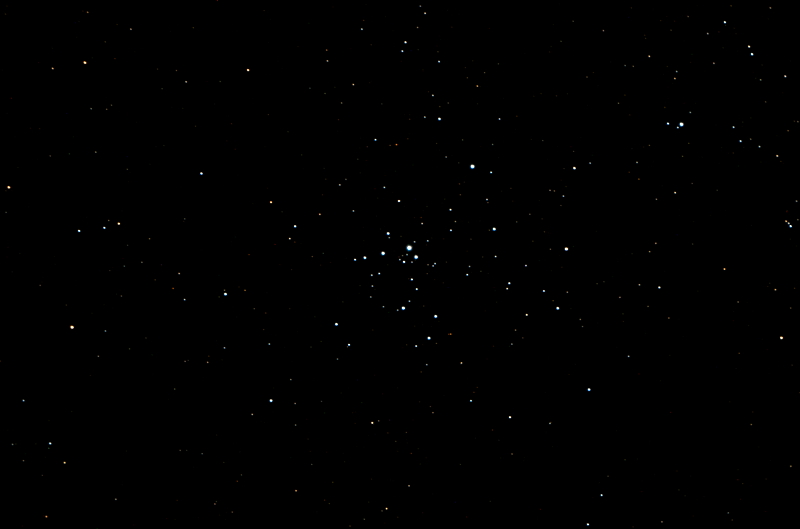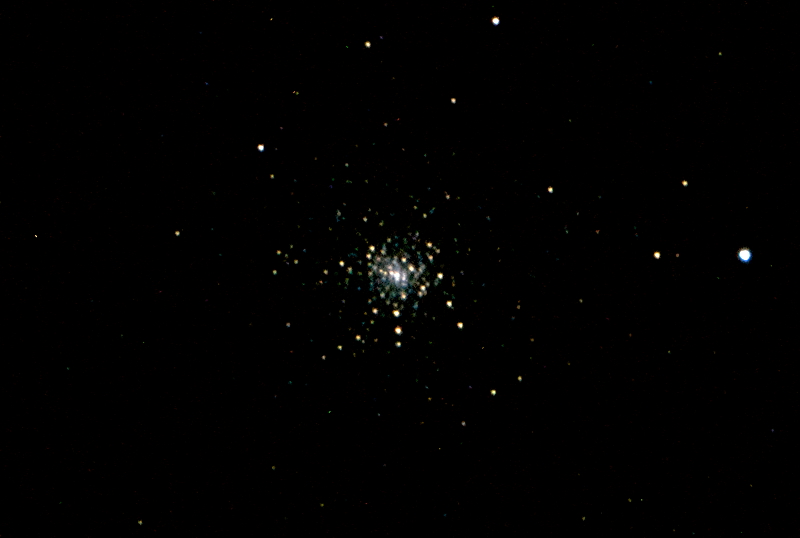Busy Night Imaging Messier Star Clusters, Comet C/2014 E2;
iPhone 5s Star Trails
Posted: 30 August 2014
When I was setting up for D7000 DSLR imaging on the previous session I discovered that my Nikon EH-5a AC adapter had failed. I did some troubleshooting on Thursday, 28 August 2014, and it was definitely dead. This adapter had been purchased in Feburary 2008 as a replacement for one that was part of my astro gear that was stolen. This model has now been discontinued; the newer model EH-5b has been ordered from B&H Photo. It should arrive next week.
Cloudy skies returned on Thursday, but Friday was clear.
|
Opened: Friday, 29 August 2014, 1844 MST Temperature: 98°F |
Session: 712 Conditions: Clear |
1852 MST: sunset. Viewed the moon, 83X. Then synced observatory clock to WWV. That was followed by more lunar observing, 222X. The southern polar region was nice, as well as the crater Gutenberg. Mounted the D7000 DSLR at prime focus of the 8" LX200-ACF using a TPO 2" adapter. This is a 1/320sec, ISO 1600, exposure:

This is the crater Gutenberg, "Hat Trick", ISO 100, prime focus + 2X PowerMate, cropped from the full-frame image:

And the southern polar region, Hat Trick, ISO 100, also cropped:

1927 MST: resumed lunar observing, 444X. Did this handheld iPhone 5s photo of crater Gutenberg, cropped to a similar scale as the D7000 DSLR image above:

1946 MST: enjoyed viewing earthshine on the moon, 83X. Lots of details were visible on the lunar surface. Then viewed Mars, 83X; no details seen. Switched to 222X; a dark area was visible and possibly the North Polar Cap, but seeing was not good enough due to the planet's low altitude to positively identify the features. Next, viewed Saturn, 222X. Cassini Division, shadows, and the moons Titan, Dione, Tethys, and Rhea were visible.
2022 MST: began setting up for Messier star cluster imaging. After reading Allan Hall's book "Messier Astrophotography Reference", I had decided to complete my imaging of all the Messier objects, and retake some images that were not ideal. This night I would do star clusters. Mounted the D7000 DSLR at prime focus using the TPO 2" adapter. Did a focus test image on the star Antares using the Bahtinov Mask. The following globular clusters (cropped from the full-frame image) and open clusters (full-frame) were imaged using the exposures noted:
M62 (globular cluster), 30 seconds, ISO 1600

M107 (globular cluster), 1 minute, ISO 1600

M6 (Butterfly Cluster, open cluster), 30 seconds, ISO 500

M7 (open cluster), 30 seconds, ISO 400

M18 (open cluster), 30 seconds, ISO 800

M21 (open cluster), 30 seconds, ISO 400

M23 (open cluster), 30 seconds, ISO 500

M24 (open cluster), 30 seconds, ISO 800

M25 (open cluster), 30 seconds, ISO 800

M26 (open cluster), 30 seconds, ISO 800

M15 (globular cluster), 30 seconds, ISO 800

M72 (globular cluster), 1 minute, ISO 1600

M13 (globular cluster), 30 seconds, ISO 800

M2 (globular cluster), 30 seconds, ISO 400

M30 (globular cluster), 30 seconds, ISO 800

M56 (globular cluster), 1 minute, ISO 1600

Completed Messier object imaging at 2223 MST. The open cluster M24 really needs a wider field. I'll redo the image on a future session using the focal reducer.
I then did a quick visual check of the focus using the Bahtinov Mask on the star Vega. Powered on the GC Wi-Fi Adapter and used SkySafari Pro on the iPhone 5s to GOTO Comet C/2014 E2 Jacques. I captured the comet using 30 seconds, ISO 4000, exposures every 1 minute to show the comet's rapid motion in five minutes:

Click (or tap) image to see animated GIF (1.2MB)
2247 MST: ended DSLR imaging for the night. Did some brief observing of the comet, 83X. No tail was visible but the coma was good.
Then set up to take a star trail photograph using the iPhone 5s. "Star trails" using an iPhone? How is that possible? By using the iOS app "NightCap Pro" and following the developer's instructions. I mounted the iPhone 5s on a POD bay wall using the Joby GripTight GorillaPod Stand:

This is a 30 minute exposure of the northern sky (bright star at the bottom is Polaris):

Focus was a challenge, as well as avoiding camera movement when touching the onscreen shutter button. I'm looking forward to what the developer will be able to do using the soon-to-be-released iOS 8. I'm hoping for manual focus, exposure length control, and remote shutter release using the earphone/mic volume button (which currently only works with the Apple Camera app). But this image shows that star trails can be captured using the iPhone.
2348 MST: Viewed Neptune, 83X. It was a small pale blue dot. The planet's disk was more obvious at 222X. Then viewed Uranus, 222X. It's disk was good with a pale green color.
2355 MST: began some DSO observing using the Cometron 12x70 binoculars. Viewed M45 (the Pleiades), M31 (the Andromeda Galaxy) and its companion galaxies M32 and M110, M33 (Triangulum Galaxy), Double Cluster, and NGC7000 (North America Nebula). All were very nice views in the 12x70 binoculars.
I then did some comparison sky quality readings using a Unihedron SQM-L meter and the iOS app "Dark Sky Meter". Tried to submit the SQM reading to Globe at Night, but it would not accept a time after midnight and the date as "2014/08/30"; it wanted a date between 08/15 and 08/24.
This was a fun and busy night at Cassiopeia Observatory.
|
Closed: Saturday, 30 August 2014, 0026 MST Temperature: 77°F |
|
I have posted my Comparison: 2" vs 1.25" Prime Focus DSLR Adapters. Check it out.
Comments are welcome using Email. If you are on Twitter you can use the button below to tweet this report to your followers. Thanks.
Cassiopeia Observatory Home Page
Copyright ©2014 Michael L. Weasner / mweasner@me.com
URL = http://www.weasner.com/co/Reports/2014/08/30/index.html
